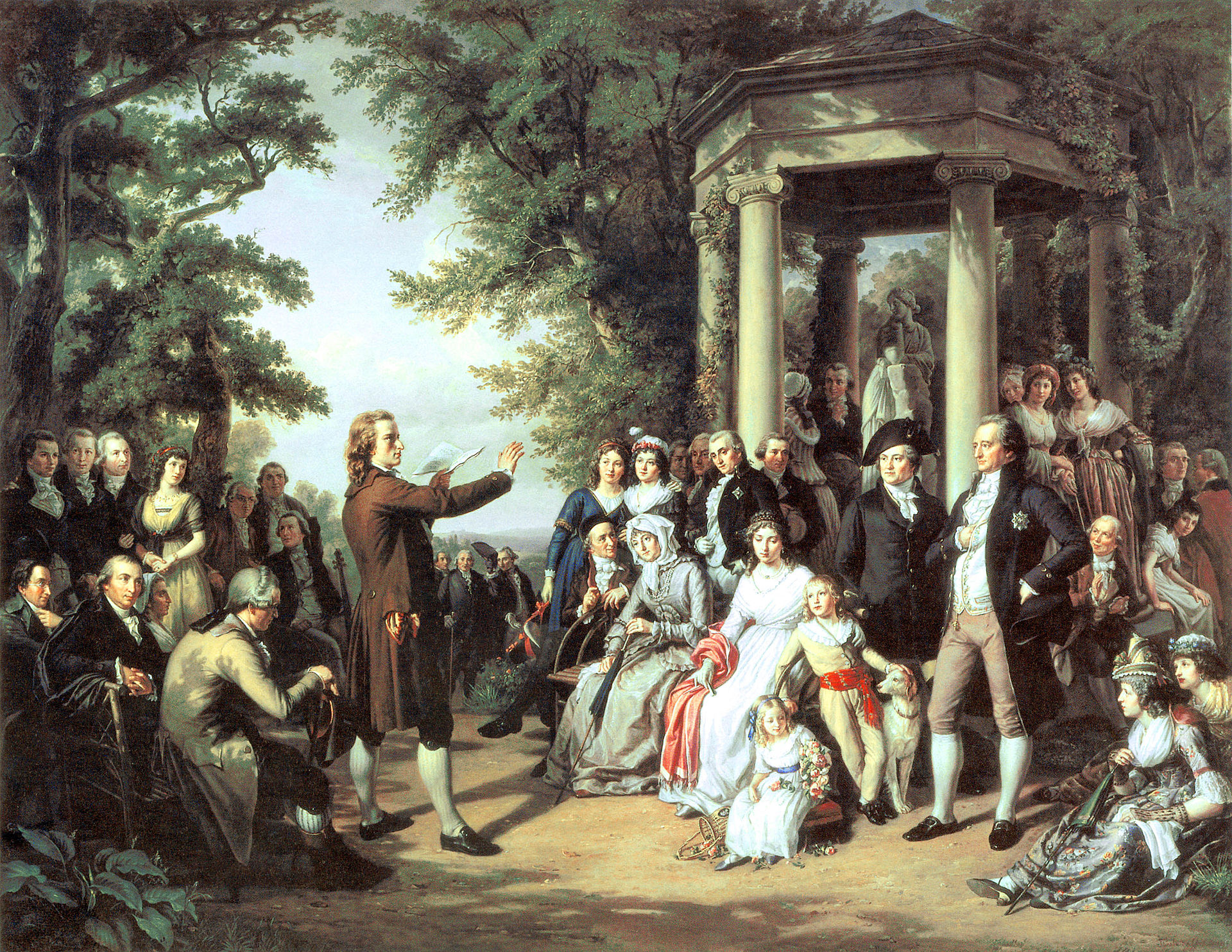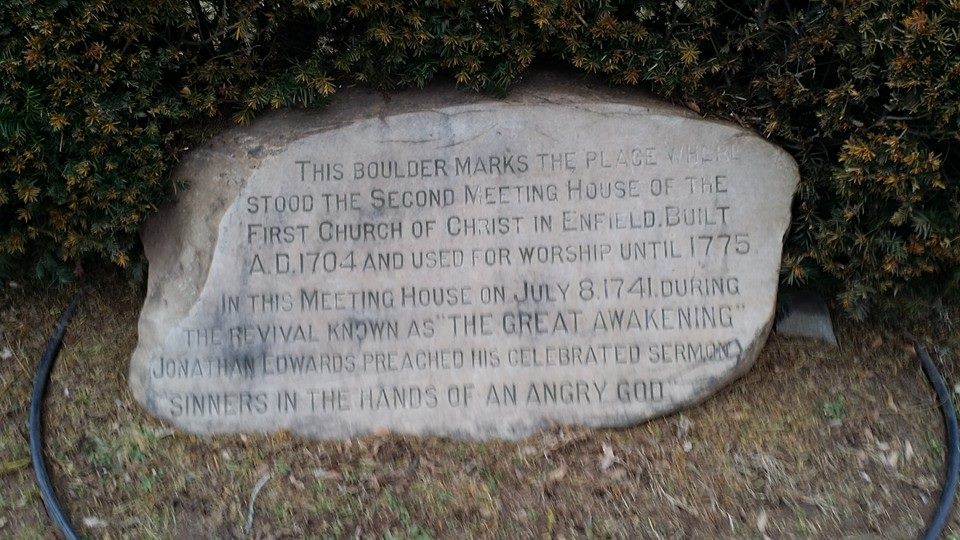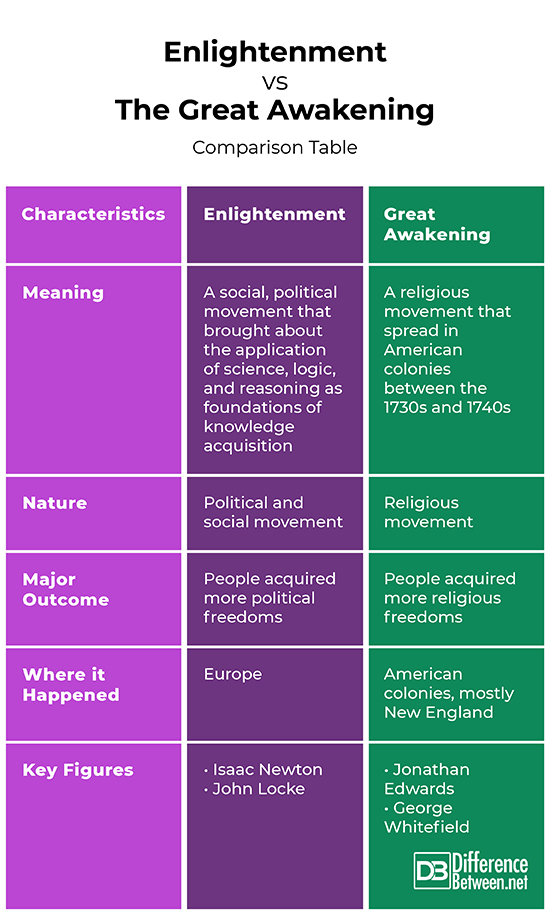Difference Between Enlightenment and Great Awakening
The two phases refer to movements that are associated with awakening the minds of American colonies and Europe countries to start thinking for themselves. They made them realize that they were also capable of ruling or leading themselves, both politically and religiously. The revolutions also changed their mindsets about their particular societies, religious affiliations, as well as their mother country.
The movements also enlightened the American and Europe citizens as they realized they needed not to depend on their countries for survival. With the two phases almost being similar, one would ask whether there is a difference between them.
What is Enlightenment?
This is also referred to as the Age of Reason. It was an age of intellectual and cultural movements that started in the 18th Century and emphasized the application of reasoning and science over superstition and blind faith respectively.
The widely known initiators of Enlightenment included Isaac Newton of the Law of Gravity, John Locke, and Voltaire. These men questioned the widely accepted knowledge of how things came to be and instead sought to spread new ideas based on investigation, openness, and religious tolerance across North America and Europe.
Most people consider the age of Enlightenment as the time when Western civilization was born. They also view it as an age that gave way for the age of light to replace the age of darkness.
Ideas Around Enlightenment
The ideas the age of Enlightenment was enshrined on include:
- Cosmopolitanism: – where people view themselves as citizens and can actively engage themselves in the world.
- Empiricism: – that knowledge comes from observation and experiencing the world.
- Rationalism: – humans should use their faculty of reasoning to gain knowledge.
- Progressivism: – humans can use their reasoning and observation powers to make unlimited and linear progress over time.
What is the Great Awakening?
This was a religious revolution that started in the late 1720s in Europe (mostly England) and then spread to different American colonies by the turn of 1730s. George Whitefield and the father and son duo (Gilbert and William Tennent led the religious fervor revivals in the affected colonies for over 30 years.
When the age of reasoning happened, it is not all American ministers who were swept by it. Jonathan Edwards, for example, was a Yale minister who never got to convert to the Church of England. This is because he was concerned about New Englanders becoming too involved with wordy matters, the pursuit of wealth, and shunning John Calvin’s religious teachings and principles.
The events that followed included suggestions that predestination was wrong and that a soul could be saved by good deeds. These happenings sparked what came to be known as the Great Awakening.
Impacts of the Great Awakening
The movement resulted in:
- Creation of new schools, for example, Princeton University and churches.
- Americans got divided with some following the new era ministers and other following the ministers who refused to follow or accept the new religion style.
- Great religious toleration.
Similarities Between Enlightenment and the Great Awakening
The two movements were similar in various ways such as:
- They both changed how people thought or perceived “old” ideas, cultures, and beliefs.
- They both took place around the 1700s.
- Both movements also championed for more freedoms and independent mindsets.
- Both revolutions also rebelled against the authorities.
Difference Between Enlightenment Vs. The Great Awakening
The following are some of the major differences between the two revolutions:
-
Meaning of Enlightenment Vs. The Great Awakening
Enlightenment refers to a political and social movement that took place around the 17th and 18th Centuries and saw science, logic, and reason get accepted as the foundations of gaining knowledge. The Great Awakening, on the other hand, is a religious movement that happened in American colonies between the 1730s and 1740s.
-
Characteristics of Enlightenment Vs. The Great Awakening
The Enlightenment phase saw:
- People apply logic and reason to all aspects of society.
- People started focusing on how governments are set up and run.
- They also realized the natural rights they had including the basic rights to life, liberty, the pursuit of happiness, and right to own property.
- Social contracts that is, the relationship between people and their governments were formed.
During the Great Awakening phase:
- Some people rebelled against church leaders and their teachings. They began to question the “old” ways of doing things.
- The movement also saw the creation of protestant churches.
- People questioned that if they could have spiritual freedom, what would prevent them from having a political one.
-
Where They Took Place
The Great Awakening took place in American colonies, and mostly New England while Enlightenment took place in Europe.
-
Key Figures
The key figures around Enlightenment include:
- John Comenius
- Hugo Grotius
- Thomas Hobbes
- John Locke
- Charles-Louis de Secondat, (Baron de Montesquieu)
- Isaac Newton
- Thomas Jefferson
The key figures that championed for the Great Awakening include:
- George Whitefield
- Gilbert & William Tennent
- The Wesley Brothers
Enlightenment Vs. The Great Awakening: Comparison Table
Summary of Enlightenment Vs. The Great Awakening
As it is with major historical events, the Enlightenment and The Great Awakening had their driving powers. They also had different figures that championed for each as well as the tenets. Even though the structures behind them were almost similar, the two revolutions had their differences. While one happened in North America, the other one happened in Europe as religious and social economic movements respectively.
- Difference Between Minecraft and Terraria - August 7, 2020
- Difference Between Alliteration and Onomatopoeia Poems - July 25, 2019
- Difference Between Certification and Licensure - July 24, 2019
Search DifferenceBetween.net :
Leave a Response
References :
[0]Image credit: https://en.wikipedia.org/wiki/Age_of_Enlightenment#/media/File:Oer-Weimarer_Musenhof.jpg
[1]Image credit: https://en.wikipedia.org/wiki/First_Great_Awakening#/media/File:JE_Sinners_in_the_Hands_Monument.jpg
[2]"The Great Awakening." Gale Library of Daily Life: Slavery in America. . Encyclopedia.com. 6 May. 2019
[3]"7 Enlightenment & Great Awakening | History Hub". Sites.Austincc.Edu, 2019, http://sites.austincc.edu/caddis/Enlightenment-great-awakening/.
[4]"The Enlightenment". Live Science, 2019, https://www.livescience.com/55327-the-Enlightenment.html. Accessed 6 May 2019.
[5]"The Great Awakening [Ushistory.Org]". Ushistory.Org, 2019, http://www.ushistory.org/us/7b.asp.
[6]"The Impact Of Enlightenment In Europe [Ushistory.Org]". Ushistory.Org, 2019, http://www.ushistory.org/us/7a.asp.



